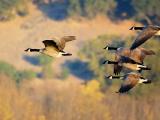Apr 13, 2010
Satellite tracking suggests ducks can carry H5N1 long distances
American and Japanese scientists say their satellite tracking of wild ducks during an H5N1 avian influenza outbreak in Japan suggests that wild birds may help to spread the often deadly virus. The authors, from the US Geological Survey Alaska Science Center and the University of Tokyo, attached satellite transmitters to 66 northern pintail ducks in Japan, according to their report in Ibis. Several months later, the H5N1 virus was found in dead and dying whooper swans at wetlands in Japan. The tracking devices revealed that eight of the marked ducks used the same wetlands area as the swans, and five were present shortly before the virus was found in the swans, though it is not known if the ducks were infected. Ducks such as pintails can shed the virus orally and in feces for a week after they are infected. Some of the marked pintails migrated 700 miles within 4 days after leaving the outbreak site, and four ultimately traveled 2,000 miles to nesting sites in eastern Russia. The finding that the ducks migrated long distances at a time when a newly infected duck would have been shedding the virus suggests the possibility that ducks can spread the virus over large areas, the scientists say. In a news release, USGS scientist Jerry Hupp, PhD, one of the authors, said the H5N1 virus has been found in northern pintails, which show no signs of illness when infected.
Apr 2010 Ibis abstract
Apr 12 USGS press release
Researchers trace disease spread with new genetic mapping tool
Scientists have developed a Web-based mapping project to help researchers put raw genetic sequence data about infectious disease pathogens into a useful format that can help national security and public health officials track disease threats. Scientists unveiled the application, called Supramap, in the Apr 9 issue of Cladistics. The application displays the spread of pathogens and their key mutations across, time, space, and various hosts. Lead author Dr Ward Wheeler, a curator at the American Museum of Natural History, one of the groups that collaborated on the Supramap project, said in a press release that the tool also has predictive power, for example, to show how climate change may spark a shift in bird flyways and affect where avian flu might strike next. The system operates on high-performance computers at Ohio State University and the Ohio Supercomputer Center.
Apr 12 American Museum of Natural History press release
Apr 9 Cladistics abstract
Aggressive Salmonella strains seen in African HIV patients
Invasive and drug-resistant Salmonella strains are emerging in people from Africa infected with HIV, researchers from the University of Liverpool reported in the April issue of Clinical Infectious Diseases. Loss of immune cells in HIV disease allows the Salmonella strains, unique to Africa, to invade cells in the blood and bone where they can remain and develop multi-drug resistance. The researchers cultured blood from 495 Malawian patients to gauge Salmonella in blood and marrow. They say the findings point to treatment challenges.
Apr 1 Clin Infect Dis abstract
Apr 12 University of Liverpool press release
















